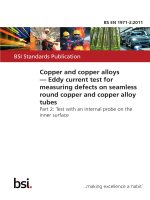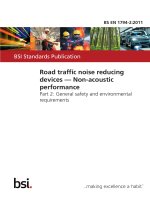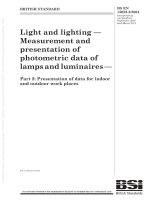Bsi bs en 62150 2 2011
Bạn đang xem bản rút gọn của tài liệu. Xem và tải ngay bản đầy đủ của tài liệu tại đây (1.03 MB, 28 trang )
BS EN 62150-2:2011
BSI Standards Publication
Fibre optic active
components and devices —
Test and measurement
procedures
Part 2: ATM-PON transceivers
BRITISH STANDARD
BS EN 62150-2:2011
National foreword
This British Standard is the UK implementation of EN 62150-2:2011. It is
identical to IEC 62150-2:2010. It supersedes BS EN 62150-2:2004 which is
withdrawn.
The UK participation in its preparation was entrusted by Technical Committee
GEL/86, Fibre optics, to Subcommittee GEL/86/3, Fibre optic systems and
active devices.
A list of organizations represented on this committee can be obtained on
request to its secretary.
This publication does not purport to include all the necessary provisions of a
contract. Users are responsible for its correct application.
© BSI 2011
ISBN 978 0 580 69286 4
ICS 33.180.20
Compliance with a British Standard cannot confer immunity from
legal obligations.
This British Standard was published under the authority of the Standards
Policy and Strategy Committee on 28 February 2011.
Amendments issued since publication
Amd. No.
Date
Text affected
BS EN 62150-2:2011
EUROPEAN STANDARD
EN 62150-2
NORME EUROPÉENNE
January 2011
EUROPÄISCHE NORM
ICS 33.180.20
Supersedes EN 62150-2:2004
English version
Fibre optic active components and devices Test and measurement procedures Part 2: ATM-PON transceivers
(IEC 62150-2:2010)
Composants et dispositifs actifs à fibres
optiques Procédures d'essais et de mesures Partie 2: Emetteurs-récepteurs ATM-PON
(CEI 62150-2:2010)
Aktive Lichtwellenleiter-Bauteile
und -Bauelemente Prüf- und Messverfahren Teil 2: ATM-PON-Sende- und
Empfangsmodule
(IEC 62150-2:2010)
This European Standard was approved by CENELEC on 2011-01-13. CENELEC members are bound to comply
with the CEN/CENELEC Internal Regulations which stipulate the conditions for giving this European Standard
the status of a national standard without any alteration.
Up-to-date lists and bibliographical references concerning such national standards may be obtained on
application to the Central Secretariat or to any CENELEC member.
This European Standard exists in three official versions (English, French, German). A version in any other
language made by translation under the responsibility of a CENELEC member into its own language and notified
to the Central Secretariat has the same status as the official versions.
CENELEC members are the national electrotechnical committees of Austria, Belgium, Bulgaria, Croatia, Cyprus,
the Czech Republic, Denmark, Estonia, Finland, France, Germany, Greece, Hungary, Iceland, Ireland, Italy,
Latvia, Lithuania, Luxembourg, Malta, the Netherlands, Norway, Poland, Portugal, Romania, Slovakia, Slovenia,
Spain, Sweden, Switzerland and the United Kingdom.
CENELEC
European Committee for Electrotechnical Standardization
Comité Européen de Normalisation Electrotechnique
Europäisches Komitee für Elektrotechnische Normung
Management Centre: Avenue Marnix 17, B - 1000 Brussels
© 2011 CENELEC -
All rights of exploitation in any form and by any means reserved worldwide for CENELEC members.
Ref. No. EN 62150-2:2011 E
BS EN 62150-2:2011
EN 62150-2:2011
-2-
Foreword
The text of document 86C/974/FDIS, future edition 2 of IEC 62150-2, prepared by SC 86C, Fibre optic
systems and active devices, of IEC TC 86, Fibre optics, was submitted to the IEC-CENELEC parallel vote
and was approved by CENELEC as EN 62150-2 on 2011-01-13.
This European Standard supersedes EN 62150-2:2004.
The significant technical change to EN 62150-2:2004 is:
The power meter requires higher saturation power than 2 × Pmean for Pave measurement in 7.3.3.
Attention is drawn to the possibility that some of the elements of this document may be the subject of
patent rights. CEN and CENELEC shall not be held responsible for identifying any or all such patent
rights.
The following dates were fixed:
– latest date by which the EN has to be implemented
at national level by publication of an identical
national standard or by endorsement
(dop)
2011-10-13
– latest date by which the national standards conflicting
with the EN have to be withdrawn
(dow)
2014-01-13
Annex ZA has been added by CENELEC.
__________
Endorsement notice
The text of the International Standard IEC 62150-2:2010 was approved by CENELEC as a European
Standard without any modification.
In the official version, for Bibliography, the following notes have to be added for the standards indicated:
IEC 60617 series
NOTE Harmonized in EN 60617 series (not modified).
IEC 60793 series
NOTE Harmonized in EN 60793 series (not modified).
IEC 60794 series
NOTE Harmonized in EN 60794 series (not modified).
IEC 60874 series
NOTE Harmonized in EN 60874 series (not modified).
IEC 61280 series
NOTE Harmonized in EN 61280 series (not modified).
IEC 61300 series
NOTE Harmonized in EN 61300 series (not modified).
IEC 61315:1995
NOTE Harmonized as EN 61315:1997 (not modified).
IEC 62148-6
NOTE Harmonized as EN 62148-6.
__________
BS EN 62150-2:2011
EN 62150-2:2011
-3-
Annex ZA
(normative)
Normative references to international publications
with their corresponding European publications
The following referenced documents are indispensable for the application of this document. For dated
references, only the edition cited applies. For undated references, the latest edition of the referenced
document (including any amendments) applies.
NOTE When an international publication has been modified by common modifications, indicated by (mod), the relevant EN/HD
applies.
Publication
Year
Title
EN/HD
Year
1)
IEC 61280-1-3
1998
Fibre optic communication subsystem basic EN 61280-1-3
test procedures Part 1-3: Test procedures for general
communication subsystems - Central
wavelength and spectral width measurement
1999
IEC 61280-2-2
2008
Fibre optic communication subsystem test
EN 61280-2-2
procedures Part 2-2: Digital systems - Optical eye pattern,
waveform and extinction ratio measurement
2008
IEC 62149-5
2009
Fibre optic active components and devices - EN 62149-5
Performance standards Part 5: ATM-PON transceivers with LD driver
and CDR ICs
201X
ITU-T G.983.1
-
Broadband optical access systems based on Passive Optical Networks (PON)
-
1)
EN 61280-1-3 is superseded by EN 61280-1-3:2010, which is based on IEC 61280-1-3:2010.
2)
To be published.
2)
BS EN 62150-2:2011
–2–
62150-2 Ó IEC:2010
CONTENTS
INTRODUCTION ............................................................................................................ 6
1
Scope ...................................................................................................................... 7
2
Normative references ................................................................................................ 7
3
Abbreviations and symbols ........................................................................................ 7
4
3.1 Abbreviations................................................................................................... 7
3.2 Symbols .......................................................................................................... 8
Standard ambient conditions ...................................................................................... 8
5
Apparatus ................................................................................................................ 8
6
5.1
5.2
5.3
5.4
5.5
5.6
5.7
5.8
5.9
5.10
5.11
5.12
Test
7
Testing and measuring procedures ........................................................................... 10
7.1
7.2
7.3
7.4
7.5
Power supply ................................................................................................... 8
Optical power meter ......................................................................................... 9
Variable optical attenuator ................................................................................ 9
Pulse pattern generator .................................................................................... 9
Optical splitter ................................................................................................. 9
Oscilloscope .................................................................................................... 9
Optical jumper cable ......................................................................................... 9
BER detector ................................................................................................... 9
Reference Tx and reference Rx ......................................................................... 9
Calibrated optical spectrum analyzer .................................................................. 9
Low-pass filter ................................................................................................. 9
Optical-to-electrical (O/E) converter ................................................................. 10
sample ........................................................................................................... 10
Rx alarm function ........................................................................................... 10
7.1.1 Purpose ............................................................................................. 10
7.1.2 Testing and measuring configuration ..................................................... 10
7.1.3 Calibration of the optical splitter ........................................................... 10
7.1.4 Measuring procedures ......................................................................... 11
7.1.5 Testing procedures.............................................................................. 12
Tx shutdown function ...................................................................................... 12
7.2.1 Purpose ............................................................................................. 12
7.2.2 Testing configuration ........................................................................... 12
7.2.3 Testing procedures.............................................................................. 13
Mean launched power: P mean .......................................................................... 13
7.3.1 Purpose ............................................................................................. 13
7.3.2 Testing and measuring configuration ..................................................... 13
7.3.3 Measuring procedures ......................................................................... 14
7.3.4 Testing procedures.............................................................................. 15
Centroidal wavelength and spectral width ......................................................... 15
7.4.1 Purpose ............................................................................................. 15
7.4.2 Testing and measuring configuration ..................................................... 15
7.4.3 Measuring procedures ......................................................................... 15
7.4.4 Testing procedures.............................................................................. 16
Extinction ratio and mask test .......................................................................... 16
7.5.1 Purpose ............................................................................................. 16
7.5.2 Testing and measuring configuration ..................................................... 16
BS EN 62150-2:2011
62150-2 Ó IEC:2010
8
–3–
7.5.3 Measuring procedures ......................................................................... 16
7.5.4 Testing procedures.............................................................................. 17
7.6 Receiver sensitivity (S) and receiver overload (SO ) ............................................. 17
7.6.1 Purpose ............................................................................................. 17
7.6.2 Testing and measuring configuration ..................................................... 17
7.6.3 Measuring procedures ......................................................................... 18
7.6.4 Testing procedures.............................................................................. 20
Test result ............................................................................................................. 21
8.1 Required information ...................................................................................... 21
8.2 Available information ...................................................................................... 21
Bibliography ................................................................................................................. 23
Figure 1 – Testing and measuring configuration for Rx alarm function ................................ 11
Figure 2 – Relation between receiver input power and alarm voltage ................................. 12
Figure 3 – Testing and measuring configuration for transmitter shutdown function ............... 13
Figure 4 – Testing and measuring configuration for mean launched power ......................... 14
Figure 5 – Burst signal pattern ....................................................................................... 14
Figure 6 – Testing and measuring configuration for mean launched power ......................... 15
Figure 7 – Testing and measuring configuration for extinction ratio and mask test ............... 16
Figure 8 – Testing and measuring configuration for receiver sensitivity and overload ........... 18
Figure 9 – Burst signal patterns for measurement ............................................................ 19
Table 1 – Ambient conditions for carrying out measurements and tests ................................ 8
BS EN 62150-2:2011
–6–
62150-2 Ó IEC:2010
INTRODUCTION
This International Standard specifies testing and measuring procedures for optoelectronic
properties of asynchronous-transfer-mode passive optical network (ATM-PON) transceivers.
The package interface dimensions and optoelectronic performance of the transceivers are
defined in IEC 62148-6 and IEC 62149-5, respectively.
BS EN 62150-2:2011
62150-2 Ó IEC:2010
–7–
FIBRE OPTIC ACTIVE COMPONENTS AND DEVICES –
TEST AND MEASUREMENT PROCEDURES –
Part 2: ATM-PON transceivers
1
Scope
This part of IEC 62150 specifies testing and measuring procedures for fibre optic transceivers
for asynchronous-transfer-mode passive optical network (ATM-PON) systems recommended
by ITU-T G.983.1. These testing procedures correspond to methods of examining whether the
transceivers satisfy the performance specifications defined in IEC 62149-5. On the other hand,
the measuring procedures correspond to methods of precise measurement for such
transceivers. The receiver sections of these transceivers can handle burst signals. Therefore,
some procedures described in this standard correspond to the burst signal transmission.
2
Normative references
The following referenced documents are indispensable for the application of this document.
For dated references, only the edition cited applies. For undated references, the latest edition
of the referenced document (including any amendments) applies.
IEC 61280-1-3:1998, Fibre optic communication subsystem basic test procedures – Part 1-3:
Test procedures for general communication subsystems – Central wavelength and spectral
width measurement
IEC 61280-2-2:2008, Fibre optic communication subsystem test procedures – Part 2-2: Digital
systems – Optical eye pattern, waveform and extinction ratio measurement
IEC 62149-5:2009, Fibre optic active components and devices – Performance standards –
Part 5: ATM-PON transceivers with LD driver and CDR ICs
ITU-T G.983.1, Broadband optical access systems based on Passive Optical Networks (PON)
3
Abbreviations and symbols
For the purposes of this document, the following abbreviations and symbols are applicable.
3.1
Abbreviations
BER
bit error ratio characteristic
MLM-L
multi-longitudinal mode laser diode
NRZ
non-return to zero
O/E
optical/electrical
PON
passive optical network
PRBS
pseudo random binary sequence
Rx
receiver and /or receiver section of ATM-PON transceivers
SLM-LD
single longitudinal mode laser diode
Tx
transmitter and /or transmitter section of ATM-PON transceivers
WDM
wavelength division multiplexing
BS EN 62150-2:2011
–8–
WWDM
3.2
62150-2 Ó IEC:2010
wide wavelength division multiplexing
Symbols
In order to specify the testing and measuring procedures, the following symbols are used.
A
frame length
B
burst signal length
B1
burst signal lengths for burst signal pattern 1
B2
burst signal lengths for burst signal pattern 2
n
number of the burst signals within a frame
P ave
average launched power under burst mode operation
P mean
mean launched power specified in ITU-T G.983.1
P SH
launched optical power without input to transmitter
P TH
SO
alarm threshold for received optical power
receiver overload
V ALL
low-level alarm output voltage
V ALH
high-level alarm output voltage
V SDH
high-level shutdown input voltage
V SDL
low-level shutdown input voltage
4
Standard ambient conditions
Standard ambient conditions need to be controlled within some range to ensure proper
correlation of data obtained from measurements and tests conducted in various facilities. Test
and measurement procedures shall be conducted under the following ambient conditions
unless otherwise specified. In some cases, special ambient conditions may be needed. Such
conditions can be specified in the performance standard.
Ambient conditions for carrying out measurements and tests are shown in Table 1:
Table 1 – Ambient conditions for carrying out measurements and tests
Temperature
°C
Relative humidity
%
Air pressure
KPa (mbar)
18 to 28
25 to 75
86 to 106
(860 mbar to 1 060 mbar)
Variations in ambient temperature and humidity shall be kept to a minimum during a series of
measurements.
5
5.1
Apparatus
Power supply
In the d.c. power supply, the voltage fluctuation shall not exceed ±0,5 % or 10 mV, whichever
is the larger. In the a.c. power supply, the higher harmonic content shall not exceed 5 %. If a
commercial supply is used, the higher harmonic content shall not exceed 10 %.
In tests to measure a.c. output, the ripple content of the d.c. power supply, higher harmonic
content of the a.c. power supply and a.c. impedance of the d.c. supply circuit through which
a.c. current flows shall have small values so that they will not affect the measurements. The
power supply shall be sufficient to protect against surges.
BS EN 62150-2:2011
62150-2 Ó IEC:2010
5.2
–9–
Optical power meter
The optical power meter used shall have a resolution of at least 0,1 dB and shall have been
calibrated for the wavelength and dynamic range of operation for the equipment to be tested.
5.3
Variable optical attenuator
The attenuator shall be capable of attenuation in steps of less than or equal to 0,25 dB and
should be able to provide total attenuation that is 5 dB to 10 dB more than the system gain.
Care should be taken to avoid back reflection into the Tx.
5.4
Pulse pattern generator
The pulse pattern generator shall be capable of providing to the system PRBS signals and
programmable word patterns that are consistent with the signal format (pulse shape,
amplitude, etc.) required at the system input electrical interface of the Tx device.
5.5
Optical splitter
Optical splitter (coupler) should have one input port and two output ports, equipped with
appropriate connectors. The splitting ratio for the output ports should be approximately 50 %
(unless otherwise specified). Since the ATM-PON transceiver adopts the WWDM (1,55/1,3 mm
WDM), an optical splitter whose splitting ratio has little wavelength dependence should be
used.
5.6
Oscilloscope
The oscilloscope that displays the optical and/or electrical eye patterns should have a
bandwidth well in excess of the bandwidth of the low-pass filter, so that the oscilloscope is not
the bandwidth-limiting component of the measurement system. The oscilloscope shall be
triggered either from a local clock signal that is synchronous with the optical and/or electrical
eye patterns, or from a synchronization signal derived from the optical waveform itself.
5.7
Optical jumper cable
Single-mode fibre jumper cables with the appropriate connectors shall be used.
5.8
BER detector
The BER detector evaluates the BER performance of the system with various signal formats
(programmable word pattern, PRBS, etc.).
5.9
Reference Tx and reference Rx
A Tx and/or an Rx shall be combined with the tested Tx and/or tested Rx in the measurement
configuration. The performance of the reference Tx and/or Rx shall be high enough for testing
and measuring of the optoelectronic properties of ATM-PON transceivers. Especially
important is that the reference Tx have a bandwidth that is much higher than 155,52 Mbit/s
and an extinction ratio of more than 10 dB.
5.10
Calibrated optical spectrum analyzer
The test equipment shall utilize a dispersive spectro-photometric method to resolve the optical
spectral distribution. The resolution for MLM-LDs shall be better than 0,2 nm, and 0,1 nm for
SLM-LDs, with a 50 nm range for both types of LDs.
5.11
Low-pass filter
To ensure repeatability and accuracy, a low-pass filter that has the following characteristics
shall be located in the signal path before the oscilloscope.
BS EN 62150-2:2011
– 10 –
62150-2 Ó IEC:2010
Low-pass filter characteristics:
characteristic impedance:
50 W nominal
–3 dB bandwidth:
0,75/T Hz, where T is the bit interval of the data signal
filter type:
4 th -order Bessel-Thomson
Further filter specifications are described in 3.1.3 of IEC 61280-2-2.
5.12
Optical-to-electrical (O/E) converter
The O/E converter shall be typically a high-speed photodiode, followed by electrical amplifiers
and shall be able to reproduce the optical waveform with sufficient fidelity to ensure a
meaningful measurement. Further specifications are described in 3.1.1 of IEC 61280-2-2.
6
Test sample
The test sample shall be an ATM-PON transceiver having the performance defined in
IEC 62149-5. The tested transceiver shall be installed in each testing and/or measuring
configuration, as shown in the figures in each subclause.
7
Testing and measuring procedures
7.1
Rx alarm function
7.1.1
Purpose
The alarm output voltage shall be changed from high to low when the incident optical signal
power is below the threshold value (PTH: –30 dBm for class B transceiver, –33 dBm for
class C transceiver). This subclause defines the testing and measuring procedures for the Rx
alarm function of the ATM-PON transceiver.
7.1.2
Testing and measuring configuration
Unless otherwise specified, a tested ATM-PON transceiver and a reference Tx shall be
installed in the measuring and testing configuration, as shown in Figure 1.
7.1.3
Calibration of the optical splitter
The calibration of the optical splitter shall be carried out as follows:
a) Before measurement and testing, the optical splitter shall be calibrated as stated below.
b) Operate the reference Tx under normal operating conditions and apply the 155,52 Mbit/sNRZ-PRBS 2 23 –1 signal (mark ratio 50 %) to the signal input terminal.
c) Connect the optical output port of the reference Tx with the input port of the optical splitter
through the jumper cable and variable optical attenuator.
d) Connect output port A of the optical splitter with the input port of the optical power meter
through the jumper cable.
e) Adjust the variable optical attenuator so that the output optical power of port A is around
P TH. Record its value (P A ).
f)
Connect output port B of the optical splitter with the input port of the optical power meter
through the jumper cable and record the optical power of port B (P B).
g) Connect output port A of the optical splitter with the input port of optical power meter
through the jumper cable again. Connect output port B of the optical splitter with the
tested ATM-PON transceiver, as shown in Figure 1.
BS EN 62150-2:2011
62150-2 Ó IEC:2010
– 11 –
h) Calculate the ratio of P B /P A and use it as a calibration factor between the incident optical
power (P B) and optical power meter indication (P A ).
Power supply and pulse
pattern generator
Optical
power
meter
Jumper
Cable
G
DC power supply
Variable optical
attenuator
Referenc e
Tx
Port A
Optical
splitter
Port B
ATM-PON
transceiver
under test
V ALH
or
V ALL
Jumper c able
IEC
2821/10
Figure 1 – Testing and measuring configuration for Rx alarm function
7.1.4
Measuring procedures
The measuring procedures shall be carried out as follows:
a) Drive the tested ATM-PON transceiver under normal operating conditions and confirm that
the alarm output voltage is in the low-level (V ALL ) range specified in IEC 62149-5.
b) The tested ATM-PON transceiver and a reference Tx shall be installed in the configuration
shown in Figure 1.
c) Apply the 155,52 Mbit/s-NRZ-PRBS 2 23 –1 signal (mark ratio 50 %) to the signal input
terminal.
d) Adjust the variable optical attenuator so that P B is much lower than PTH and record the P B
value as a P IL.
e) Adjust the variable optical attenuator so that P B exceeds PTH and record the alarm output
voltage.
f)
Confirm that the alarm output voltage is changed from low-level (V ALL ) to high-level (V ALH )
specified in IEC 62149-5 when P B is around P TH .
g) Adjust the variable optical attenuator so that P B reaches the overload value (SO ) and
record the alarm output voltage and confirm that the alarm output voltage is in the highlevel (V ALH ) range specified in IEC 62149-5.
h) Adjust the variable optical attenuator so that P B reaches P IL with recording the alarm
output voltage.
i)
Confirm that the alarm output voltage is changed from high-level (V ALH ) to low-level (V ALL )
when P B is below P IL.
As a result of the above procedures, a relation between P B and the alarm output voltage is
obtained as a hysteresis curve as shown in Figure 2. This hysteresis curve is the
measurement data of receiver alarm function.
BS EN 62150-2:2011
V ALH
– 12 –
62150-2 Ó IEC:2010
P TH
SO
max.
min.
Alarm
output
voltage
V ALL
max.
min.
P IL
Receiver input optical power (P B)
IEC
2822/10
Figure 2 – Relation between receiver input power and alarm voltage
7.1.5
Testing procedures
The testing procedures shall be carried out as follows:
a) Operate the tested ATM-PON transceiver under normal operating conditions and confirm
that the alarm output voltage is in the low-level (V ALL ) range.
b) The tested ATM-PON transceiver and a reference Tx shall be installed in the configuration
shown in Figure 1.
c) Apply the 155,52 Mbit/s-NRZ-PRBS 2 23 –1 signal (mark ratio 50 %) to the signal input
terminal.
d) Adjust the variable optical attenuator so that the P B coincides with PTH and confirm that
the alarm output voltage is in the high-level (V ALH ) range. Record the V ALH value.
e) Adjust the valuable optical attenuator so that the P B is much lower than PTH and confirm
that the alarm output voltage is in the low-level (V ALL ) range. Record the V ALL value.
7.2
7.2.1
Tx shutdown function
Purpose
The output optical power shall be decreased to be less than launched optical power without
input signal or P SH (–40 dBm for class B transceivers, –43 dBm for class C transceivers)
when the applied high-level voltage of the shutdown terminal is changed to low-level. This
clause defines the testing procedures for the Tx shutdown function of the ATM-PON
transceiver.
7.2.2
Testing configuration
Unless otherwise specified, a tested transceiver shall be installed in the testing configuration,
as shown in Figure 3.
BS EN 62150-2:2011
62150-2 Ó IEC:2010
Power supply and
pulse pattern generator
– 13 –
G
ATM-PON
transceiver
under test
Jumper c able
Optical
power
meter
VSDH or VSDL
IEC
2823/10
Figure 3 – Testing and measuring configuration for transmitter shutdown function
7.2.3
Testing procedures
The testing procedures shall be carried out as follows:
a) Operate the tested ATM-PON transceiver under normal operating conditions and apply the
high-level voltage (from 2,0 V to Vcc + 0,3 V) to the shutdown terminal of the tested
transceiver.
b) Apply the 155,52 Mbit/s-NRZ-PRBS 2 23 –1 signal (mark ratio 50 %) to the signal input
terminal and confirm that the average output power from the tested transceiver is within
the specified range for P mean (mean launched power) (from –4 dBm to +2 dBm for class B
modules, from –2 dBm to +4 dBm for class C modules, see IEC 62149-5).
c) Change the applied high-level voltage to low-level voltage (from –0,3 V to 0,8 V) and
confirm that the average output power from the tested transceiver is less than P SH.
d) Change the applied low-level voltage to high-level voltage and confirm that the average
output power from the tested transceiver is within the specified range for P mean (from
–4 dBm to +2 dBm for class B modules, from –2 dBm to +4 dBm for class C modules).
7.3
7.3.1
Mean launched power: P mean
Purpose
This subclause defines the testing and measuring procedures for the mean launched power of
the ATM-PON transceiver.
7.3.2
Testing and measuring configuration
Unless otherwise specified, a tested transceiver shall be installed in the measuring and
testing configuration as shown in Figure 4.
BS EN 62150-2:2011
– 14 –
Voltage sourc e and
pulse pattern generator
G
DC power
supply
Data
62150-2 Ó IEC:2010
Clock
Jumper c able
(pigtail fibre)
ATM-PON
transceiver
under test
Optical
power
meter
IEC
2824/10
Figure 4 – Testing and measuring configuration for mean launched power
7.3.3
Measuring procedures
The measuring procedures shall be carried out as follows:
a) Design a burst signal pattern defined by frame length A, burst signal length B and the
number of the burst signals within a frame n, as shown in Figure 5. B is 56 bytes for ATMPON transceivers.
Optical
power
Burst signal length: B
Time
Frame length: A
NOTE
IEC
2825/10
“The number of the burst signals within a frame n.”: in this figure, for illustration, n = 3.
Figure 5 – Burst signal pattern
b) Operate the tested ATM-PON transceiver under normal operating conditions and apply the
designed burst signal pattern to the signal input terminal from the pattern generator.
c) Measure the average optical signal power or P ave with the optical power meter and record it.
d) Calculate P mean by the following equation:
P mean = P ave ´ [A/(n ´ B)]
(1)
It requires that saturation power of the power meter is higher than 2 ´ P mean during P avg
measurement.
BS EN 62150-2:2011
62150-2 Ó IEC:2010
7.3.4
– 15 –
Testing procedures
The testing procedures shall be carried out as follows:
a) Operate the tested ATM-PON transceiver under normal operating conditions and apply the
155,52 Mbit/s-NRZ-PRBS 2 23 –1 signal to the signal input terminal. This PRBS signal
corresponds to a “A = n ´ B” case of a burst signal.
b) Measure the average optical signal power P ave with the optical power meter and record it
as P mean .
c) Confirm that measured P mean is within the specified range of P mean .
7.4
7.4.1
Centroidal wavelength and spectral width
Purpose
This subclause defines the testing and measuring procedures for the centroidal wavelength
( l ave) and spectral width of the ATM-PON transceiver.
7.4.2
Testing and measuring configuration
Unless otherwise specified, the tested transceiver shall be installed in the measuring and
testing configuration, as shown in Figure 6.
Power supply and
pulse pattern generator
G
Power
supply
Data
Clock
ATM-PON
transceiver
under test
Jumper c able
(pigtail fibre)
Calibrated
optic al
spectrum
analyzer
IEC
2826/10
Figure 6 – Testing and measuring configuration for mean launched power
7.4.3
Measuring procedures
The measuring procedures shall be carried out as follows:
a) Design a burst signal pattern defined by frame length A, burst signal length B, and the
number of the burst signals within a frame n as shown in Figure 5. B is 56 bytes for ATMPON transceivers.
b) Operate the tested ATM-PON transceiver under normal operating conditions and apply the
designed burst signal pattern to the signal input terminal from the pattern generator.
c) Display the optical signal spectrum on the display of the optical spectral analyzer.
d) According to 5.6 of IEC 61280-1-3, adjust the resolution, centroidal wavelength, span
width, and averaging count (more than 10 times is recommended) of the optical spectral
analyzer so that the 20-dB-down width spectrum appears on the display.
BS EN 62150-2:2011
62150-2 Ó IEC:2010
– 16 –
e) Record the peak wavelength and peak power of each longitudinal mode which is included
in the 20-dB-down spectrum. Calculate l ave and spectral width according to 6.2 and 6.4 of
IEC 61280-1-3.
7.4.4
Testing procedures
The testing procedures shall be carried out as follows:
a) Operate the tested ATM-PON transceiver under normal operating conditions and apply the
155,52 Mbit/s-NRZ-PRBS 2 23 –1 signal to the signal input terminal. This PRBS signal
corresponds to a “A = n ´ B” case of a burst signal.
b) Display the optical signal spectrum on the display of the optical spectral analyzer.
c) According to 5.6 of IEC 61280-1-3, adjust the resolution, centroidal wavelength, span
width, and averaging count (more than 10 times is recommended) of the optical spectral
analyzer so that the 20-dB-down width spectrum appears on the display.
d) Record the peak wavelength and peak power of each longitudinal mode included in
20-dB-down spectrum. Calculate l ave and spectral width according to 6.2 and 6.4 of
IEC 61280-1-3.
e) Confirm that the calculated l ave is within its specified range (from 1 260 nm to 1 360 nm).
7.5
Extinction ratio and mask test
7.5.1
Purpose
This subclause defines the testing and measuring procedures for the extinction ratio and
mask test of the ATM-PON transceiver.
7.5.2
Testing and measuring configuration
Unless otherwise specified, the tested transceiver shall be installed in the measuring and
testing configuration as shown in Figure 7. If necessary, an optical attenuator shall be
installed between the tested ATM-PON transceiver and O/E converter.
Power supply and
pulse pattern generator
for burst signal
G
Trigger for testing
Power
supply
Data
ATM-PON
transceiver
under test
Trigger for measuring
Clock
Jumper c able
(pigtail fibre)
O/E
converter
Low-pass
filter
Oscilloscope
IEC
2827/10
Figure 7 – Testing and measuring configuration for extinction ratio and mask test
7.5.3
Measuring procedures
The measuring procedures shall be carried out as follows:
BS EN 62150-2:2011
62150-2 Ó IEC:2010
– 17 –
a) Design a burst signal pattern defined by frame length A, burst signal length B, and the
number of the burst signals within a frame n as shown in Figure 5. B is 56 bytes for ATMPON transceivers.
b) Operate the tested ATM-PON transceiver under normal operating conditions and apply the
designed burst signal pattern to the signal input terminal from the pulse pattern generator.
The burst signal itself or its envelope signal should be used as a trigger for the
oscilloscope to reduce the timing jitter.
c) Display the optical signal waveform, which will have been converted into the electrical
waveform by the O/E converter, on the display of the oscilloscope.
d) According to IEC 61280-2-2, calculate the extinction ratio and perform the mask test using
the masks defined in ITU-T G.983.1.
e) Repeat the above calculation and mask test for each burst signal within a frame.
7.5.4
Testing procedures
The testing procedures shall be carried out as follows:
a) Operate the tested ATM-PON transceiver under normal operating conditions and apply the
155,52 Mbit/s-NRZ-PRBS 2 23 –1 signal to the signal input terminal. This PRBS signal
corresponds to a “A = n ´ B” case of a burst signal.
b) The clock signal from the pulse pattern generator is used as a trigger for the oscilloscope.
c) Display the optical signal waveform, which will have been converted into the electrical
waveform by the O/E converter, on a display of an oscilloscope.
d) According to IEC 61280-2-2, calculate the extinction ratio and perform the mask test using
the masks defined in ITU-T G.983.1.
e) Confirm that the mask test has passed or failed and that the calculated extinction ratio is
within its specified range (from 5,8 dB to 10 dB).
7.6
7.6.1
Receiver sensitivity (S) and receiver overload (S O )
Purpose
This subclause defines the testing and measuring procedures for the receiver sensitivity
(S: –30 dBm for class B modules, –33 dBm for class C modules) and receiver overload
(S O :–8 dBm for class B modules, –11 dBm for class C modules) of the ATM-PON transceiver.
7.6.2
Testing and measuring configuration
Unless otherwise specified, the tested transceiver shall be installed in the measuring and
testing configuration as shown in Figure 8. Optical splitters whose calibration factors have
been estimated by the procedures described in 7.1.3 shall be installed in this configuration. If
more than 40-dB-attenuation can be obtained by the variable attenuator-1 and -2 in Figure 8,
alternative procedures denoted by * can be taken.
BS EN 62150-2:2011
62150-2 Ó IEC:2010
– 18 –
Oscilloscope
Variable optical
attenuator-1
O/E converter
Burstsignal-1
Referenc e
Tx-1
Burst signal-2
Optical power
meter
Optical
splitter-1
Optical
splitter-2
ATM-PON
transceiver
under test
Referenc e
Tx-2
Variable optical
attenuator-2
Power
supply
Power supply and
pulse pattern
generator
for burst signal
Data
Clock
Clock
Data
BER detector
for burst signal
G
Clock
Data
Clock (Note)
Clock
Data
IEC
2828/10
NOTE This dashed line is a res erve clock signal connection. Usually this connection is not nec essary. W hen th e
clock signal output from the ATM-PON transceiver does not meet the electrical signal interfac e of the BER detector,
this connection provides the clock signal between the ATM-PON transceiver and BER detector.
Figure 8 – Testing and measuring configuration for receiver sensitivity and overload
7.6.3
Measuring procedures
The measuring procedures shall be carried out as follows:
a) Design two burst signal patterns, denoted in Figures 9a) and 9b) as burst-signal-1 and
burst-signal-2, respectively. Both signal patterns have the same frame length A and
number of the burst signals within a frame n. In addition, burst signal length B1 and B2 are
also the same for ATM-PON transceivers and are 56 bytes.
BS EN 62150-2:2011
62150-2 Ó IEC:2010
– 19 –
Burst signal
length: B1
Optical
power
-----
Time
Frame length: A
a) Burst-signal-1 (output from reference Tx-1)
IEC
2829/10
Optical
power
Burst signal
length: B2
-----
Frame length: A
Time
b) Burst-signal-2 (output from reference Tx-2)
IEC
Burst signal
length: B1
2830/10
Burst signal
length: B2
Optical
power
T
Time
Frame length: A
c) Incident optical signal on the tested ATM-PON transceiver
IEC
Figure 9 – Burst signal patterns for measurement
2831/10
BS EN 62150-2:2011
– 20 –
62150-2 Ó IEC:2010
b)
Operate the reference Tx-1 and Tx-2 under normal operating condition. Apply burstsignal-1 to the signal input terminals of the reference Tx-1 and burst-signal-2 to the signal
input terminals of the reference Tx-2, respectively.
c)
Monitor the optical output signal from the optical splitter-1 by connecting it with a
oscilloscope through an O/E converter (see a part in Figure 8 drawn by dashed line) and
adjust the signal delay of the pulse pattern generator so that the timing difference
between these two burst signals, T, is more than the duration of a bit. (see Figure 9c).
d)
Connect the output of the optical splitter-1 with the input of the optical splitter-2 again.
e)
Turn off burst-signal-2.
* Adjust the variable optical attenuator-2 to the maximum attenuation.
f)
Read the optical power meter and calculate the optical power of burst-signal-1 incident
on the ATM-PON transceiver by using the calibration factor of the optical splitter and
Equation (1).
g) Adjust the variable optical attenuator-1 so that the calculated optical powers of burstsignal-1 become –9 dBm for class B and –12 dBm for class C modules, respectively, and
mark down or memorize the adjusted position of it.
h) Turn off the burst-signal-1 and turn on the burst-signal-2.
* Adjust the variable optical attenuator-1 to the maximum attenuation.
i)
j)
Adjust the variable optical attenuator-2 so that the calculated optical power of burstsignal-2 becomes close to the specified receiver sensitivity or receiver overload.
Turn on burst-signal-1 again.
*Adjust the variable optical attenuator-1 to the marked or memorized position.
k)
Monitor BER performance of burst-signal-2 for more than the time duration given by the
following equation:
[A/(data rate ´ n ´ B2)] ´ (1/guaranteed BER) ´ N (s)
(2)
where N >10 is recommended.
l)
Record the calculated optical power of burst-signal-2 and corresponding BER by
repeating the procedures from h) to k).
m) Plot the optical power of burst-signal-2 vs. BER and clarify the receiver sensitivity and
receiver overload at the BER of 1 ´ 10 –10 .
7.6.4
Testing procedures
The testing procedures shall be carried out as follows:
a) Design two burst signal patterns denoted in Figures 9a) and 9b) as burst-signal-1 and
burst-signal-2, respectively. Both signal patterns have the same frame length A and
number of burst signals within a frame n. In addition, burst signal length B1 and B2 are
also the same for ATM-PON transceivers and are 56 bytes.
b) Operate the reference Tx-1 and Tx-2 under normal operating conditions. Apply burstsignal-1 to the signal input terminals of the reference Tx-1 and burst-signal-2 to the signal
input terminals of the reference Tx-2, respectively.
c) Monitor the optical output signal from the optical splitter-1 by connecting it with a
oscilloscope through an O/E converter (see a part in Figure 8 drawn by dashed line) and
adjust the signal delay of the pulse pattern generator so that the timing difference
between these two burst signals T is more than the duration of a bit (see Figure 9c).
d) Connect the output of the optical splitter-1 with the input of the optical splitter-2 again.
e) Turn off burst-signal-2.
*Adjust the variable optical attenuator-2 to the maximum attenuation.
BS EN 62150-2:2011
62150-2 Ó IEC:2010
f)
– 21 –
Read the optical power meter and calculate an optical power of burst-signal-1 incident on
the ATM-PON transceiver by using the calibration factor of the optical splitter and
Equation (1).
g) Adjust the variable optical attenuator-1 so that the calculated optical powers of burstsignal-1 become –9 dBm for class B and –12 dBm for class C modules, respectively, and
mark down or memorize the adjusted position of it.
h) Turn off the burst-signal-1 and turn on the burst-signal-2.
*Adjust the variable optical attenuator-1 to the maximum attenuation.
i)
Adjust the variable optical attenuator-2 so that the calculated optical power of burstsignal-2 is more than the specified receiver sensitivity.
j)
Turn on burst-signal-1 again.
*Adjust the variable optical attenuator–1 to the marked or memorized position.
k) Monitor BER performance for more than the duration given by Equation (2) and confirm
that BER of the burst-signal-2 is less than 1 ´ 10–10.
l)
Turn off burst-signal-1.
*Adjust the variable optical attenuator-1 to the maximum attenuation.
m) Adjust the variable optical attenuator-2 so that the calculated optical power of burstsignal-2 is less than the specified receiver overload.
n) Turn on burst-signal-1 again.
*Adjust the variable optical attenuator–1 to the marked or memorized position.
o) Monitor BER performance for more than the duration given by Equation (2) and confirm
that the BER of burst-signal-2 is less than 1 ´ 10–10.
8
8.1
Test result
Required information
The required information shall include :
·
date and title of the test;
·
identification of normal operating conditions of the ATM-PON transceiver;
·
results of the test, including ambient or reference point temperature and humidity;
·
calibration method of optical power meter;
·
recording method of the average output power from the tested transceiver.
8.2
Available information
The available information shall include:
·
identification of the test equipment used and the measurement uncertainty due to the
accuracy and resolution of the optical power meter;
·
identification of fibre jumper cable and connector parameters;
·
optical power measurement uncertainty;
·
names of test personnel;
·
supply voltage(s) and/or current(s);
·
data rate and input signal characteristics;
·
input/output measurement conditions: wavelength, reference Tx and tested Rx mating
connector model number, Rx sensitivity, maximum receiver input;
·
recommended warm-up time for reference Tx, reference Rx and tested ATM-PON
transceiver;
BS EN 62150-2:2011
– 22 –
62150-2 Ó IEC:2010
·
extended operating conditions, if applicable;
·
influence of the optical signal reflection on the transceiver characteristics that is called
“Tolerance to the transmitter incident light power” (see 5.5 and Figure 5 of IEC 62149-5).
BS EN 62150-2:2011
62150-2 Ó IEC:2010
– 23 –
Bibliography
IEC 60617, Graphical symbols for diagrams
IEC 60793 (all parts), Optical fibres
IEC 60794 (all parts), Optical fibre cables
IEC 60874 (all parts), Connectors for optical fibres and cables
IEC 61280 (all parts), Fibre optic communication subsystem test procedures
IEC 61300 (all parts), Fibre optic interconnecting devices and passive components – Basic
test and measurement procedures
IEC 61315:1995, Calibration of fibre optic power meters
IEC/TR 61930:1998, Fibre optic graphical symbology
IEC/TR 61931:1998, Fibre optic – Terminology
IEC 62148-6, Fibre optic active components and devices – Package and interface standards –
Part 6: ATM-PON transceivers
ISO 1101:1983, Technical drawings – Geometrical tolerancing – Tolerancing of form,
orientation, location and run-out – Generalities, definitions, symbols, indications on drawings
__________









